SECTION I - CLASS DEFINITION
This class provides for design patents claiming ornamental
designs for textiles, woven fabrics, yard goods, and sheet material-type
products that show an indeterminate length or width.
1. Perforated or openwork panel material
2. Combined unidirectional and bidirectional pattern
3. Unidirectional
4. Paisley-type pattern
5. Plaid or tartan-type pattern
6. Pattern created by texture or open weave
7. Pattern formed by tracery of uniform line
8. Zigzag or wave pattern
9. Pattern formed by stippled effect
10. Pattern formed on grid or graph matrix
11. Reverse, rotated, or alternating pattern element
12. Linear arrangement of adjacent pattern elements or striated
13. Single isolated systematically repeating element
14. Random arrangement of pattern elements within repeat unit
15. Appliqué, medallion or singular pattern unit
16. Miscellaneous
| | (1)
Note. This class includes material which, as disclosed and
claimed, indicates repetition beyond the limits of the disclosure. |
| | (2)
Note. The material in this class has indeterminate length
or width. Material with specific limits or suggestion thereof (such
as a disclosure of a corner) is classified in another pertinent
Design Class such as D6, D11, or D25. However, singular pattern segments
or material with disclosed limits which are not identified as subject
matter for other classes are classified in this Class, subclass
63 and indented subclasses. |
SECTION II - REFERENCES TO OTHER CLASSES
SEE OR SEARCH CLASS:
| 26, | Textiles: Cloth Finishing, for pertinent subclass(es) as determined by schedule
review. |
| 28, | Textiles: Manufacturing, for pertinent subclass(es) as determined by schedule
review. |
| 139, | Textiles: Weaving, for pertinent subclass(es) as determined by schedule
review. |
| 162, | Paper Making and Fiber Liberation, for pertinent subclass(es) as determined by schedule review. |
| 264, | Plastic and Non-Metallic Article Shaping or Treating:
Processes, for pertinent subclass(es) as determined by schedule
review. |
| 428, | Stock Material or Miscellaneous Articles,
subclasses 914 and 915 for decals. |
| 442, | Fabric (Woven, Knitted, or Non-woven Textile or
Cloth, etc.), for pertinent subclass(es) as determined by schedule
review. |
| D2, | Apparel and Haberdashery,
subclass 978 for shoelace; subclass 999 for apparel-type pattern. |
| D6, | Furnishings,
subclass 322 for freestanding furniture-type panel; subclasses
582-594, for carpet, rug, floor mat, and tile assembled into floor
covering. |
| D9, | Packages and Containers for Goods,
subclasses 305 through 306for bag or wrapper. |
| D11, | Jewelry, Symbolic Insignia, and Ornaments,
subclasses 132 through 140for mural or pictorial unit. |
| D18, | Printing and Office Machinery,
subclasses 24 through 33for type or typeface. |
| D19, | Office Supplies, Artists and Teachers Materials,
subclass 1 for writing paper and sheet material for artwork. |
| D20, | Sales and Advertising Equipment,
subclass 11 for decal or transfer. |
| D21, | Games, Toys, and Sports Goods,
subclass 658 for paper doll and doll-type pattern. |
| D25, | Building Units and Construction Elements, for freestanding building panel; subclasses 119-135
for extrusion; subclasses 136 and 137 for elongated molding; subclasses
138-144 for architectural panel, or tile for floor, wall, or roof;
subclasses 145-163 for architectural relief carving or medallion. |
SUBCLASSES
![[List of Patents for class D5 subclass 1]](../ps.gif) 1 1 | PERFORATED OR OPENWORK PANEL MATERIAL: |
| | This subclass is indented under the class definition. Design that is characterized by openings or an open weave
or net-type configuration.
| | (1)
Note. Includes expanded metal type.
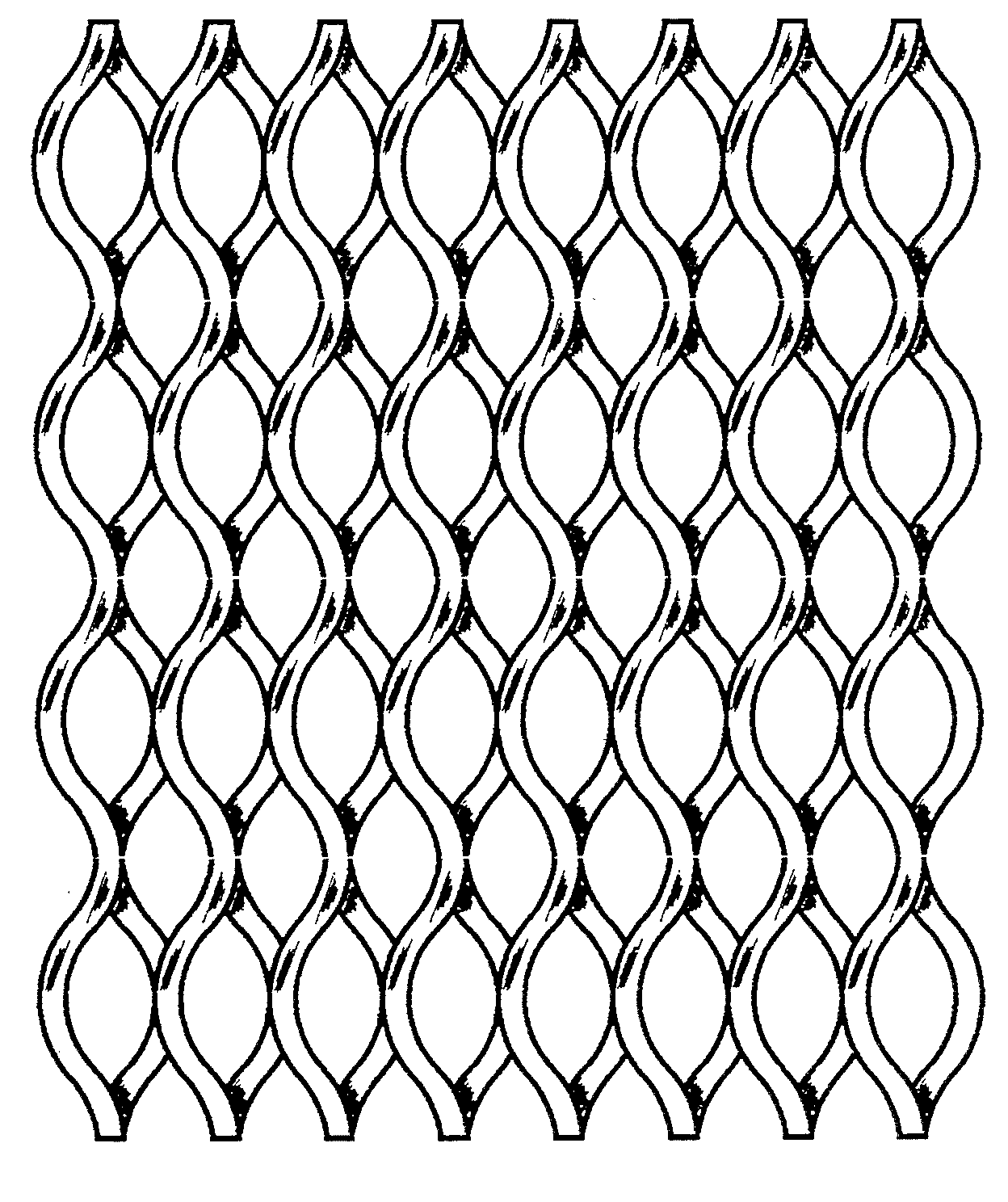
A typical example of a perforated or open work panel. | SEE OR SEARCH THIS CLASS, SUBCLASS:
| 47 | through 54, for pattern created by texture or open weave. |
SEE OR SEARCH CLASS:
| D6, | Furnishings,
subclass 322 for freestanding furniture-type panel. |
| D25, | Building Units and Construction Elements,
subclass 322
for freestanding building panel; subclasses 138-144 for architectural panel, or tile
for floor, wall, or roof. |
|
| | |
![[List of Patents for class D5 subclass 3]](../ps.gif) 3 3 | Unidirectional: |
| | This subclass is indented under subclass 1. Design for pattern or ornament that repeats or continues
in one direction only. |
| | |
![[List of Patents for class D5 subclass 4]](../ps.gif) 4 4 | COMBINED UNIDIRECTIONAL
AND BIDIRECTIONAL PATTERN: |
| | This subclass is indented under the class definition. Design that includes a repeatable, overall ornamentation
and a border that continues a single direction.
| | (1)
Note. Exclusive of selvage. |
| | (2)
Note. Includes combined overall and border pattern. | |
| | |
![[List of Patents for class D5 subclass 5]](../ps.gif) 5 5 | Simulative: |
| | This subclass is indented under subclass 4. Design that includes an ornamental feature or features
that shows the ornamental appearance of another article as applied
ornamentation.
| | (1)
Note. The search for sheet material that simulates the appearance
of another object should also include the appropriate Design Class
and subclass(es) for the actual object being simulated. | |
| | |
![[List of Patents for class D5 subclass 6]](../ps.gif) 6 6 | Plant life: |
| | This subclass is indented under subclass 5. Design that includes an ornamental feature or features
that simulate flowers, foliage, vines, trees or similar organic
material.
SEE OR SEARCH CLASS:
| D11, | Jewelry, Symbolic Insignia, and Ornaments,
subclasses 117 through 120for artificial plant life and ornaments. |
|
| | |
![[List of Patents for class D5 subclass 7]](../ps.gif) 7 7 | UNIDIRECTIONAL: |
| | This subclass is indented under the class definition. Design that includes a pattern or ornament that continues
in one direction such as a border or trim band or the like.
| | (1)
Note. Exclusive of selvage. |
| | (2)
Note. If the disclosure shows a repetition of a pattern bidirectionally,
the patent should be classified under the following main line subclasses.

A typical example of a uni-direcional ornament. | SEE OR SEARCH CLASS:
| D2, | Apparel and Haberdashery,
subclass 978 for shoelace. |
| D18, | Printing and Office Machinery,
subclasses 32 and 33 for type font-type border or ornament design. |
|
| | |
![[List of Patents for class D5 subclass 8]](../ps.gif) 8 8 | Simulative: |
| | This subclass is indented under subclass 7. Design that includes an ornamental feature or features
that shows the ornamental appearance of another article as applied
ornamentation.
| | (1)
Note. The search for sheet material that simulates the appearance
of another object should also include the appropriate Design Class
and subclass(es) for the actual object being simulated. | |
| | |
![[List of Patents for class D5 subclass 10]](../ps.gif) 10 10 | Christmas: |
| | This subclass is indented under subclass 9. Design directed to Yuletide celebration only.
SEE OR SEARCH THIS CLASS, SUBCLASS:
| 16 | and 17, for plant designs with a Christmas motif. |
|
| | |
![[List of Patents for class D5 subclass 13]](../ps.gif) 13 13 | Animate: |
| | This subclass is indented under subclass 11. Design that simulates an animal.
| | (1)
Note. Includes humanoid. |
SEE OR SEARCH CLASS:
| D18, | Printing and Office Machinery,
subclass 33 for type font-type border ornament with animate
simulation. |
|
| | |
![[List of Patents for class D5 subclass 14]](../ps.gif) 14 14 | Animate: |
| | This subclass is indented under subclass 8. Design that simulates an animal.
| | (1)
Note. Includes humanoid. | |
| | |
![[List of Patents for class D5 subclass 15]](../ps.gif) 15 15 | Architectural or geographic theme: |
| | This subclass is indented under subclass 8. Design that simulates building, structure, or map.
| | (1)
Note. Includes simulation of water. |
SEE OR SEARCH CLASS:
| D25, | Building Units and Construction Elements,
subclasses 1 through 34for structure or buildings. |
|
| | |
![[List of Patents for class D5 subclass 16]](../ps.gif) 16 16 | Plant life or plume: |
| | This subclass is indented under subclass 8. Design that includes an ornamental feature or features
that simulate flowers, foliage, vines, trees, or similar organic
material.
SEE OR SEARCH CLASS:
| D11, | Jewelry, Symbolic Insignia, and Ornaments,
subclasses 117 through 120for artificial plant life and ornaments. |
|
| | |
![[List of Patents for class D5 subclass 18]](../ps.gif) 18 18 | Fringe: |
| | This subclass is indented under subclass 7. Design for a decorative edging, cord, or strip. |
| | |
![[List of Patents for class D5 subclass 19]](../ps.gif) 19 19 | Lace or open weave type: |
| | This subclass is indented under subclass 7. Design characterized by threads or strands defining adjacent
open areas.
SEE OR SEARCH THIS CLASS, SUBCLASS:
| 11, | for lace that includes a simulative design or ornamentation. |
|
| | |
![[List of Patents for class D5 subclass 20]](../ps.gif) 20 20 | SIMULATIVE: |
| | This subclass is indented under the class definition. Design that includes an ornamental feature or features that
simulate the ornamental appearance of another object either as applied ornamentation
or in form.
| | (1)
Note. The search for a hand fan that simulates the appearance
of another object should also include the appropriate Design Class
and subclass(es) for the actual object.
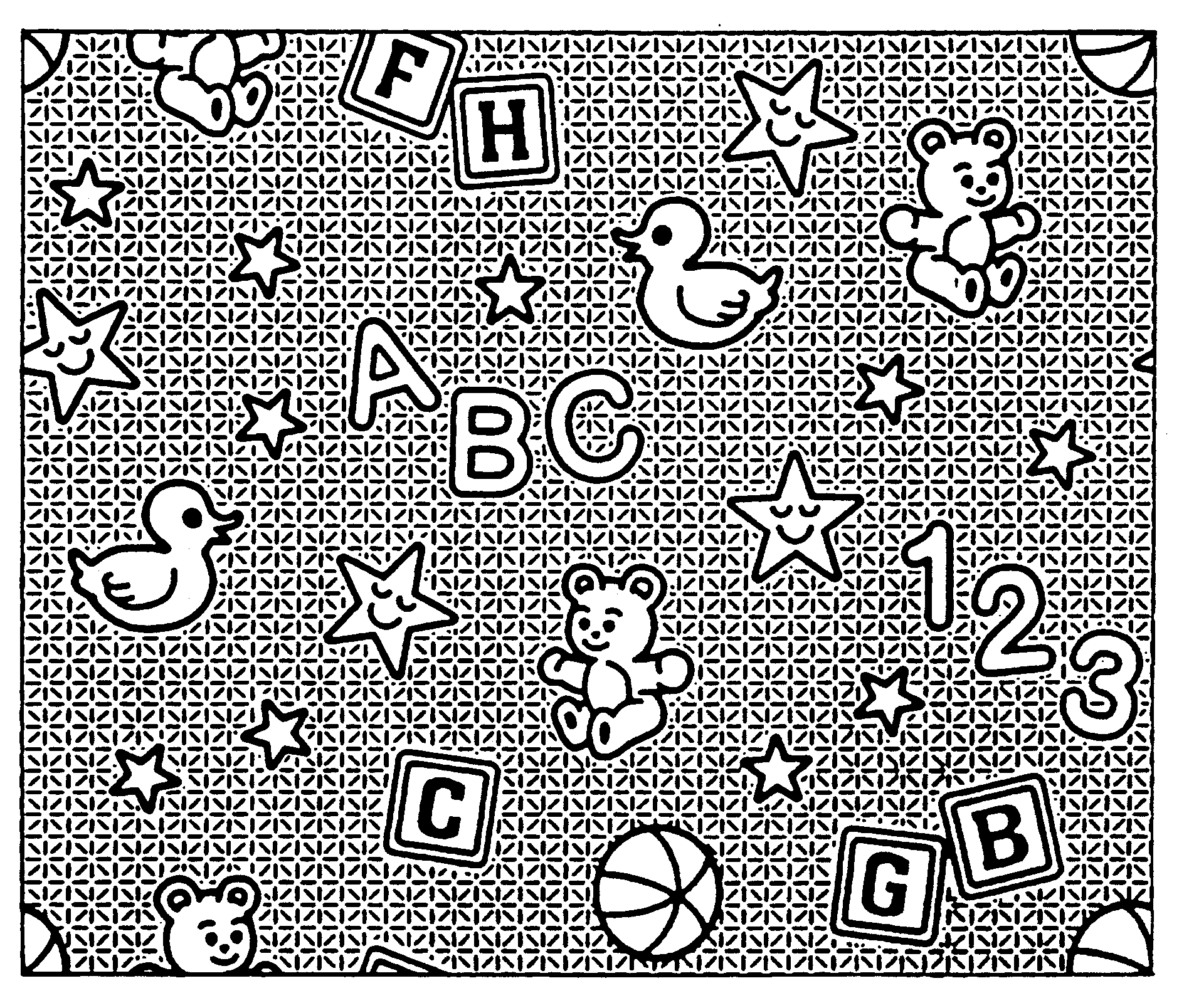
A typical example of simulative design. | |
| | |
![[List of Patents for class D5 subclass 22]](../ps.gif) 22 22 | Christmas: |
| | This subclass is indented under subclass 21. Design directed to Yuletide celebration only.
| | (1)
Note. Exclusive of plant life. |
SEE OR SEARCH THIS CLASS, SUBCLASS:
| 9, | and 10, for unidirectional trim or band with holiday
or Christmas theme. |
| 16 | and 17, for trim or band that shows plant designs
associated with Christmas. |
| 32 | through 39, for sheet material that shows plant designs associated
with Christmas. |
SEE OR SEARCH CLASS:
| D11, | Jewelry, Symbolic Insignia, and Ornaments,
subclasses 121 through 123for Christmas decorations. |
|
| | |
![[List of Patents for class D5 subclass 24]](../ps.gif) 24 24 | Plant life: |
| | This subclass is indented under subclass 23. Design that includes an ornamental feature or features
that simulate flowers, foliage, vines, trees, or similar organic
life.
SEE OR SEARCH CLASS:
| D11, | Jewelry, Symbolic Insignia, and Ornaments,
subclasses 117 through 120for artificial plant life and ornaments. |
|
| | |
![[List of Patents for class D5 subclass 26]](../ps.gif) 26 26 | Animate: |
| | This subclass is indented under subclass 20. Design that simulates an animal.
SEE OR SEARCH THIS CLASS, SUBCLASS:
| 32 | through 39, for feather or plume, per se. |
|
| | |
![[List of Patents for class D5 subclass 29]](../ps.gif) 29 29 | Architectural or geographic theme: |
| | This subclass is indented under subclass 20. Design that simulates building, structure, or map.
| | (1)
Note. Includes simulation of water. |
SEE OR SEARCH CLASS:
| D25, | Building Units and Construction Elements,
subclasses 1 through 34for structure or buildings. |
|
| | |
![[List of Patents for class D5 subclass 30]](../ps.gif) 30 30 | Letter, numeral, or punctuation: |
| | This subclass is indented under subclass 20. Design that simulates a symbol of the alphabet, or number,
mark, or symbol used in writing.
SEE OR SEARCH CLASS:
| D18, | Printing and Office Machinery,
subclasses 24 through 31for type fonts. |
| D21, | Games, Toys, and Sports Goods,
subclass 381 for playing card with alphabet motif. |
|
| | |
![[List of Patents for class D5 subclass 32]](../ps.gif) 32 32 | Plant life or plume: |
| | This subclass is indented under subclass 20. Design that includes an ornamental feature or features
that simulate flowers, foliage, vines, trees, or similar organic
material.
SEE OR SEARCH THIS CLASS, SUBCLASS:
| 43, | for wood grain simulation. |
SEE OR SEARCH CLASS:
| D11, | Jewelry, Symbolic Insignia, and Ornaments,
subclasses 117 through 120for artificial plant life and ornaments. |
|
| | |
![[List of Patents for class D5 subclass 33]](../ps.gif) 33 33 | With container: |
| | This subclass is indented under subclass 32. Design that includes a pot, vase, or plant holder.
SEE OR SEARCH CLASS:
| D11, | Jewelry, Symbolic Insignia, and Ornaments,
subclasses 143 through 163for flower or plant holder |
|
| | |
![[List of Patents for class D5 subclass 35]](../ps.gif) 35 35 | With diverse simulation: |
| | This subclass is indented under subclass 32. Design that includes a representation of another article
that is not plant life or a plant container or a ribbon or bow. |
| | |
![[List of Patents for class D5 subclass 36]](../ps.gif) 36 36 | Fruit, nut, seed pod, or vegetable: |
| | This subclass is indented under subclass 32. Design that includes a representation of seed-type product
of a plant or the edible part of a plant.
| | (1)
Note. Flower or bud excluded. |
| | (2)
Note. Includes pinecone; includes grain. | |
| | |
![[List of Patents for class D5 subclass 38]](../ps.gif) 38 38 | Fleur-de-lis |
| | This subclass is indented under subclass 37. Design that includes a representation of a stylized three-petal
iris. |
| | |
![[List of Patents for class D5 subclass 41]](../ps.gif) 41 41 | Star: |
| | This subclass is indented under subclass 20. Design that includes radiating points or a representation
of a luminous celestial body.
SEE OR SEARCH CLASS:
| D21, | Games, Toys, and Sports Goods,
subclass 380 for playing card with star motif. |
|
| | |
![[List of Patents for class D5 subclass 45]](../ps.gif) 45 45 | PAISLEY TYPE PATTERN: |
| | This subclass is indented under the class definition. Design characterized by swirled pattern of curved abstract
or feather-type shapes.
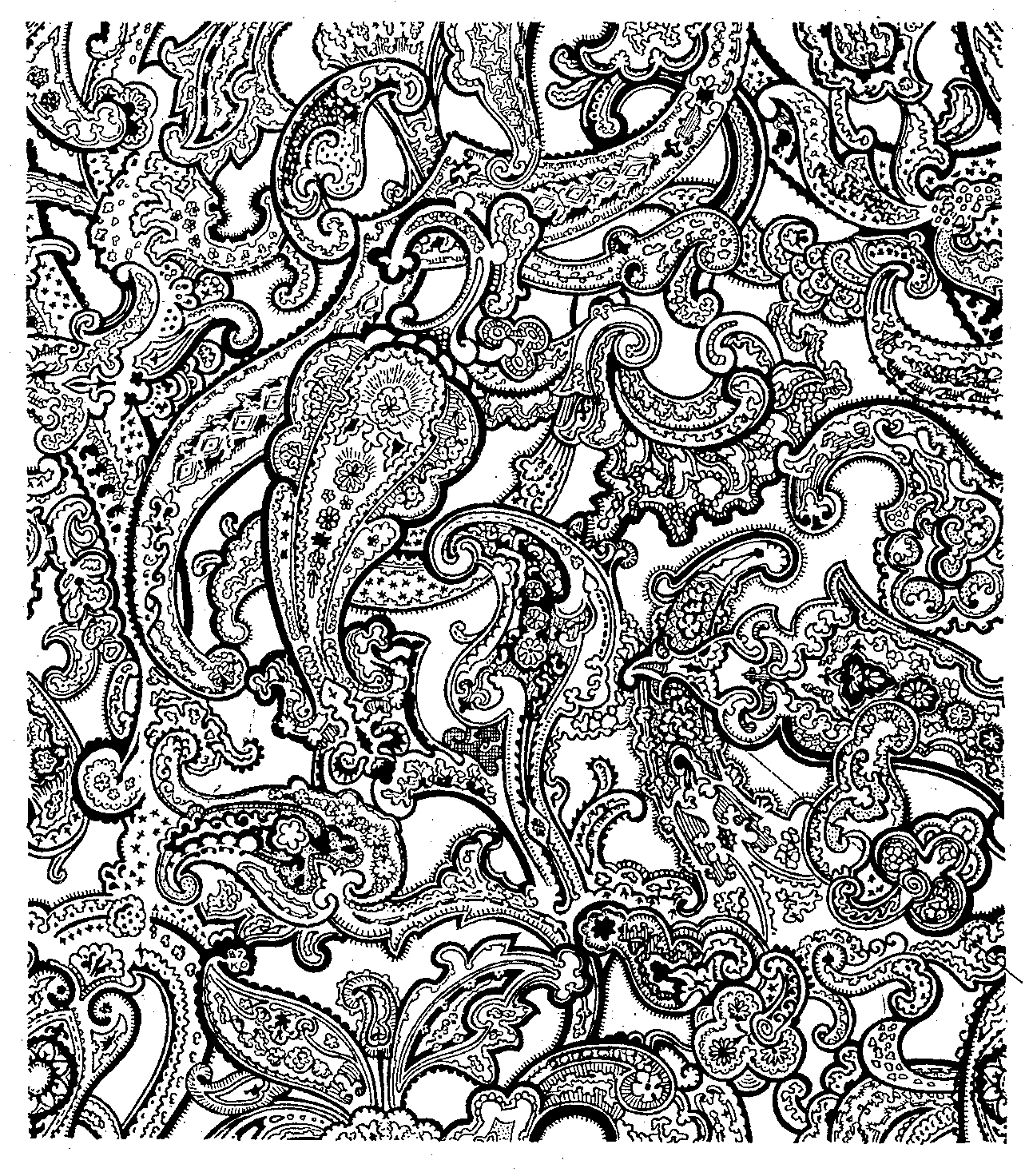
A typical example a paisley-type pattern. SEE OR SEARCH THIS CLASS, SUBCLASS:
| 63, | for appliqué, medallion, or singular pattern
unit. |
|
| | |
![[List of Patents for class D5 subclass 46]](../ps.gif) 46 46 | PLAID OR TARTAN TYPE PATTERN: |
| | This subclass is indented under the class definition. Design characterized by a pattern consisting of stripes
or lines of varying width, spacing, or contrast that intersect or
cross at right angles to one another.
| | (1)
Note. Check-type pattern excluded. | |
| | |
![[List of Patents for class D5 subclass 47]](../ps.gif) 47 47 | PATTERN CREATED BY TEXTURE OR OPEN WEAVE: |
| | This subclass is indented under the class definition. Design characterized by a pattern having a structure of
interwoven fibers or linear elements that may include open spaces.
| | (1)
Note. For classification in this or in indented subclasses,
the weave or texture itself must create the pattern as distinguished
from the pattern being applied to the material. |
| | (2)
Note. Texture must be clearly indicated by shading or by end
or cross-sectional views. | |
| | |
![[List of Patents for class D5 subclass 52]](../ps.gif) 52 52 | Shirred, gathered, or quilted: |
| | This subclass is indented under subclass 47. Design directed to material that is sewn or stitched
into decorative rows, parallel rows or by geometric forms.
| | (1)
Note. Texture must be clearly indicated by shading or by end
or cross-sectional views. | |
| | |
![[List of Patents for class D5 subclass 53]](../ps.gif) 53 53 | Embossed or puffed: |
| | This subclass is indented under subclass 47. Design directed to material that is characterized by
irregular material thickness or by a pattern of bosses or depressions.
| | (1)
Note. Embossing or puffing must be clearly indicated by shading
or by end or cross-sectional views. | |
| | |
![[List of Patents for class D5 subclass 55]](../ps.gif) 55 55 | PATTERN CREATED BY TRACERY OF UNIFORM LINE: |
| | This subclass is indented under the class definition. Design characterized by manipulated lines or filaments of
substantially constant thickness.
| | (1)
Note. Exclusive of tile delineation.
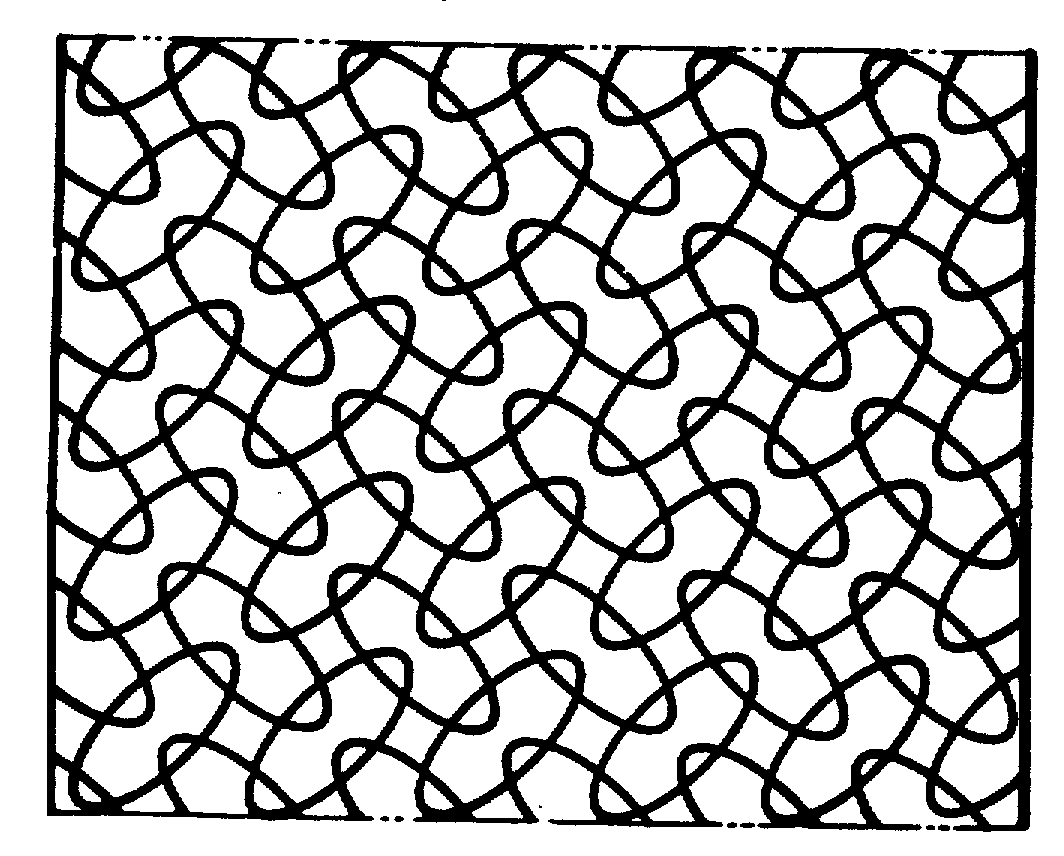
A typical example of a pattern created by tracery of uniformline. | |
| | |
![[List of Patents for class D5 subclass 56]](../ps.gif) 56 56 | ZIGZAG OR WAVE PATTERN: |
| | This subclass is indented under the class definition. Design characterized by a pattern of elements or lines that
bend or undulate sharply in alternating directions.
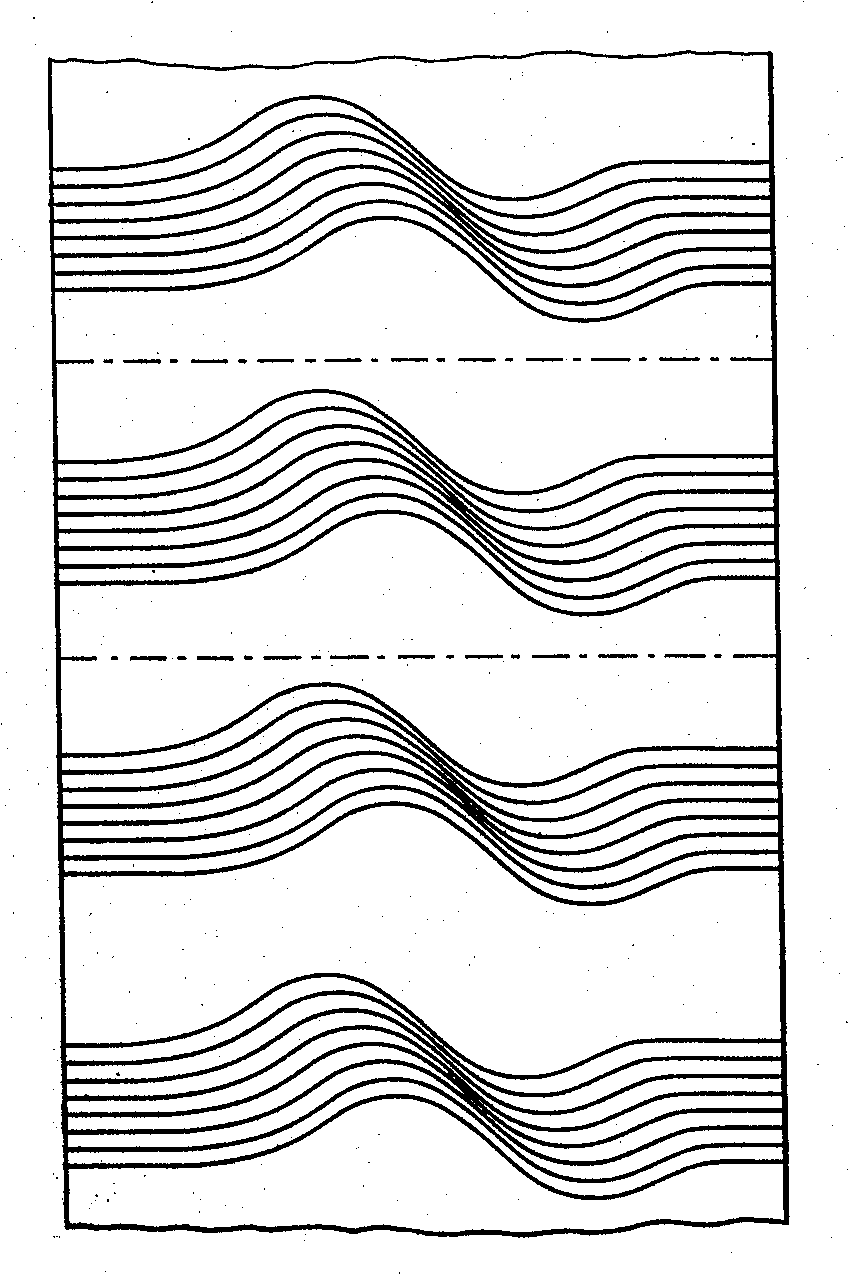
A typical example a zigzag or weave pattern. |
| | |
![[List of Patents for class D5 subclass 57]](../ps.gif) 57 57 | PATTERN FORMED BY STIPPLED EFFECT: |
| | This subclass is indented under the class definition. Design for sheet material characterized by a pattern formed
by individual dots or tiny points.
| | (1)
Note. The pattern is formed by small points or dots rather
than lines or large solid areas. | |
| | |
![[List of Patents for class D5 subclass 58]](../ps.gif) 58 58 | PATTERN FORMED ON GRID OR GRAPH MATRIX: |
| | This subclass is indented under the class definition. Design characterized by ornamentation that is structured
within or a defined or implied framework of parallel or crisscrossed
lines or bars.
| | (1)
Note. Pattern may be applied or conformed to a grid base. | |
| | |
![[List of Patents for class D5 subclass 59]](../ps.gif) 59 59 | REVERSE, ROTATED, OR ALTERNATING PATTERN ELEMENT: |
| | This subclass is indented under the class definition. Design characterized by ornamentation that includes a single
element that repeats in an alternate orientation or mirror image
of itself or is regularly interspersed with one or more similarly
repeating design elements. |
| | |
![[List of Patents for class D5 subclass 60]](../ps.gif) 60 60 | LINEAR ARRANGEMENT OF ADJACENT PATTERN ELEMENTS, OR STRIATED
SHAPES: |
| | This subclass is indented under the class definition. Design that includes stripes or the placement of single
or alternating ornamental forms in a straight line. |
| | |
![[List of Patents for class D5 subclass 61]](../ps.gif) 61 61 | SINGLE ISOLATED SYSTEMATICALLY REPEATING ELEMENT: |
| | This subclass is indented under the class definition. Design characterized by one decorative symbol that repeats
in a balanced manner. |
| | |
![[List of Patents for class D5 subclass 62]](../ps.gif) 62 62 | RANDOM ARRANGEMENT OF PATTERN ELEMENTS WITHIN REPEAT UNIT: |
| | This subclass is indented under the class definition. Design that shows no discernible repetition or pattern of
ornamental features within the basic panel.
| | (1)
Note. If repeat protocol is apparent from the disclosure,
patent is classified into earlier main line subclasses.
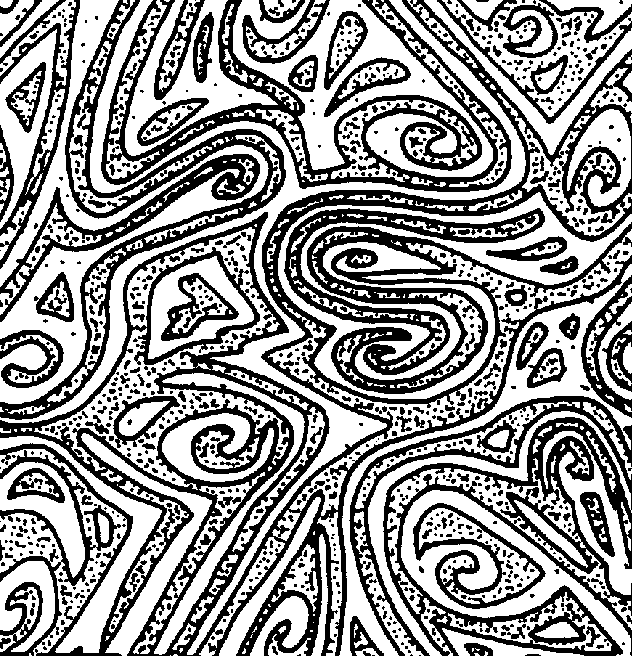
A typical example random arrangement of pattern. | |
| | |
![[List of Patents for class D5 subclass 63]](../ps.gif) 63 63 | APPLIQUÉ, MEDALLION, OR SINGLULAR PATTERN UNIT: |
| | This subclass is indented under the class definition. Design characterized by a single ornamental symbol or feature.
| | (1)
Note. Designs in this Class may have specific limits or suggestions. |
| | (2)
Note. Includes foundation or pattern for appliqué,
etc. |
| | (3)
Note. Includes insignia patch. |
| | (4)
Note. Includes decal set for repeat pattern. |
SEE OR SEARCH CLASS:
| D2, | Apparel and Haberdashery,
subclass 976 for detachable ornament for footwear. |
|
| | |
![[List of Patents for class D5 subclass 64]](../ps.gif) 64 64 | Simulative: |
| | This subclass is indented under subclass 63. Design that includes an ornamental feature or features
that simulate the ornamental appearance of another object either
as applied ornamentation.
| | (1)
Note. The search for textile or sheet material that simulates
the appearance of another object should also include the appropriate
Design Class and subclass(es) for the actual object. |
| | (2)
Note. Includes letter, numeral, or punctuation. | |
| | |
![[List of Patents for class D5 subclass 65]](../ps.gif) 65 65 | Animate: |
| | This subclass is indented under subclass 64. Design that simulates an animal.
| | (1)
Note. Includes humanoid. | |
| | |
![[List of Patents for class D5 subclass 66]](../ps.gif) 66 66 | Plant life: |
| | This subclass is indented under subclass 64. Design that includes an ornamental feature or features
that simulate flowers, foliage, vines, trees, or similar organic
material.
SEE OR SEARCH CLASS:
| D11, | Jewelry, Symbolic Insignia, and Ornaments,
subclasses 117 through 120for artificial plant life and ornaments |
|
| | |
![[List of Patents for class D5 subclass 99]](../ps.gif) 99 99 | MISCELLANEOUS: |
| | This subclass is indented under the class definition. Design that relates to textile or paper yard goods; sheet
material, not elsewhere provided for.
| | (1)
Note. Some early patents are classified in this subclass because
they (a) lack drawing disclosure or specifications, or (b) the clarity
of disclosure is insufficient to accurately place them earlier in the
schedule. For example, because of age, some drawings have faded
to the point of being unreadable. In others, drawing techniques
that do not employ current practice are inadequate to convey the
extent or rhythm of the repeat pattern. | |
| | |
![[Search a list of Patent Appplications for class D05]](../as.gif) CLASS D05,
CLASS D05,![[List of Patents for class D5 subclass 1]](../ps.gif) 1
1![[List of Patents for class D5 subclass 2]](../ps.gif) 2
2![[List of Patents for class D5 subclass 3]](../ps.gif) 3
3![[List of Patents for class D5 subclass 4]](../ps.gif) 4
4![[List of Patents for class D5 subclass 5]](../ps.gif) 5
5![[List of Patents for class D5 subclass 6]](../ps.gif) 6
6![[List of Patents for class D5 subclass 7]](../ps.gif) 7
7![[List of Patents for class D5 subclass 8]](../ps.gif) 8
8![[List of Patents for class D5 subclass 9]](../ps.gif) 9
9![[List of Patents for class D5 subclass 10]](../ps.gif) 10
10![[List of Patents for class D5 subclass 11]](../ps.gif) 11
11![[List of Patents for class D5 subclass 12]](../ps.gif) 12
12![[List of Patents for class D5 subclass 13]](../ps.gif) 13
13![[List of Patents for class D5 subclass 14]](../ps.gif) 14
14![[List of Patents for class D5 subclass 15]](../ps.gif) 15
15![[List of Patents for class D5 subclass 16]](../ps.gif) 16
16![[List of Patents for class D5 subclass 17]](../ps.gif) 17
17![[List of Patents for class D5 subclass 18]](../ps.gif) 18
18![[List of Patents for class D5 subclass 19]](../ps.gif) 19
19![[List of Patents for class D5 subclass 20]](../ps.gif) 20
20![[List of Patents for class D5 subclass 21]](../ps.gif) 21
21![[List of Patents for class D5 subclass 22]](../ps.gif) 22
22![[List of Patents for class D5 subclass 23]](../ps.gif) 23
23![[List of Patents for class D5 subclass 24]](../ps.gif) 24
24![[List of Patents for class D5 subclass 25]](../ps.gif) 25
25![[List of Patents for class D5 subclass 26]](../ps.gif) 26
26![[List of Patents for class D5 subclass 27]](../ps.gif) 27
27![[List of Patents for class D5 subclass 28]](../ps.gif) 28
28![[List of Patents for class D5 subclass 29]](../ps.gif) 29
29![[List of Patents for class D5 subclass 30]](../ps.gif) 30
30![[List of Patents for class D5 subclass 31]](../ps.gif) 31
31![[List of Patents for class D5 subclass 32]](../ps.gif) 32
32![[List of Patents for class D5 subclass 33]](../ps.gif) 33
33![[List of Patents for class D5 subclass 34]](../ps.gif) 34
34![[List of Patents for class D5 subclass 35]](../ps.gif) 35
35![[List of Patents for class D5 subclass 36]](../ps.gif) 36
36![[List of Patents for class D5 subclass 37]](../ps.gif) 37
37![[List of Patents for class D5 subclass 38]](../ps.gif) 38
38![[List of Patents for class D5 subclass 39]](../ps.gif) 39
39![[List of Patents for class D5 subclass 40]](../ps.gif) 40
40![[List of Patents for class D5 subclass 41]](../ps.gif) 41
41![[List of Patents for class D5 subclass 42]](../ps.gif) 42
42![[List of Patents for class D5 subclass 43]](../ps.gif) 43
43![[List of Patents for class D5 subclass 44]](../ps.gif) 44
44![[List of Patents for class D5 subclass 45]](../ps.gif) 45
45![[List of Patents for class D5 subclass 46]](../ps.gif) 46
46![[List of Patents for class D5 subclass 47]](../ps.gif) 47
47![[List of Patents for class D5 subclass 48]](../ps.gif) 48
48![[List of Patents for class D5 subclass 49]](../ps.gif) 49
49![[List of Patents for class D5 subclass 50]](../ps.gif) 50
50![[List of Patents for class D5 subclass 51]](../ps.gif) 51
51![[List of Patents for class D5 subclass 52]](../ps.gif) 52
52![[List of Patents for class D5 subclass 53]](../ps.gif) 53
53![[List of Patents for class D5 subclass 54]](../ps.gif) 54
54![[List of Patents for class D5 subclass 55]](../ps.gif) 55
55![[List of Patents for class D5 subclass 56]](../ps.gif) 56
56![[List of Patents for class D5 subclass 57]](../ps.gif) 57
57![[List of Patents for class D5 subclass 58]](../ps.gif) 58
58![[List of Patents for class D5 subclass 59]](../ps.gif) 59
59![[List of Patents for class D5 subclass 60]](../ps.gif) 60
60![[List of Patents for class D5 subclass 61]](../ps.gif) 61
61![[List of Patents for class D5 subclass 62]](../ps.gif) 62
62![[List of Patents for class D5 subclass 63]](../ps.gif) 63
63![[List of Patents for class D5 subclass 64]](../ps.gif) 64
64![[List of Patents for class D5 subclass 65]](../ps.gif) 65
65![[List of Patents for class D5 subclass 66]](../ps.gif) 66
66![[List of Patents for class D5 subclass 99]](../ps.gif) 99
99





